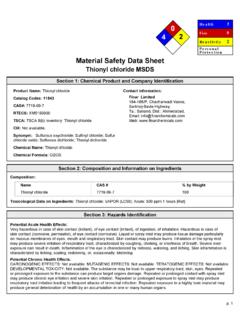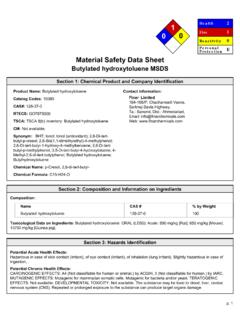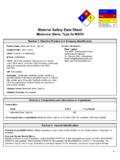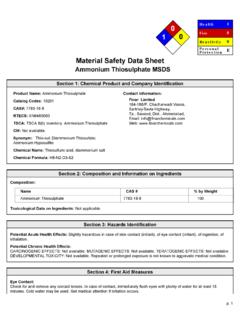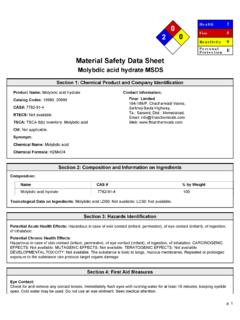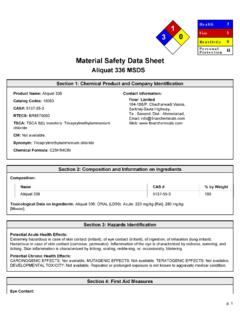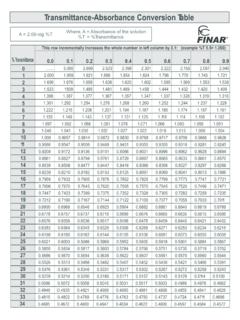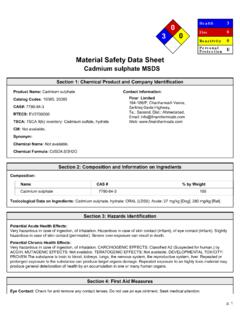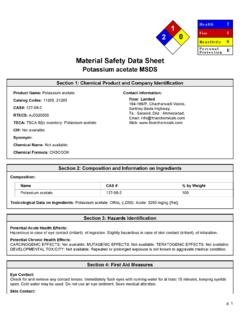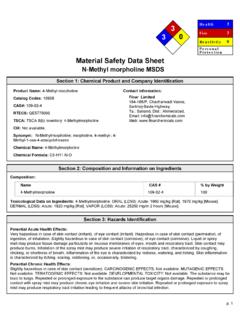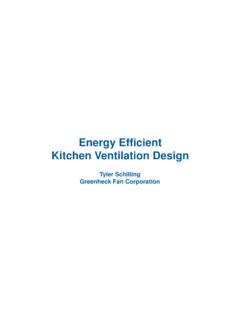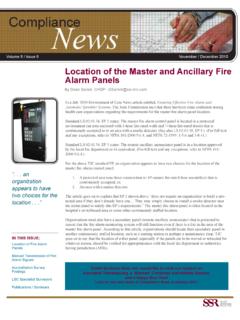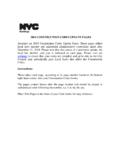Transcription of Material Safety Data Sheet - Finar Chemicals Ltd.
1 Material Safety data Sheet Kieselguhr G MSDS Section 1: Chemical Product and Company Identification Product Name: Kieselguhr G Catalog Code: 10821 CAS#: 61790-53-2 RTECS: VV7311000 TSCA: Not Available Synonym: Diatomaceous earth; Diatomaceous silica; Siliceous earth; Chemical Formula: SiO2 Contact Information: Finar Limited 184-186/P, Chacharwadi Vasna, Sarkhej-Bavla Highway, Ta.: Sanand, Dist.: Ahmedabad, Email: Web: Section 2: Composition and Information on Ingredients Composition: Name CAS #% Kieselguhr 61790-53-2 -- Section 3.
2 Hazards Identification EMERGENCY OVERVIEW Appearance: slightly gray solid. Warning! Dust may cause mechanical eye irritation. Causes respiratory tract irritation. May cause skin irritation. Contains trace amounts of quartz which may lead to fibrotic lung disease, silicosis or cancer. Target Organs: Lungs. Potential Health Effects Eye: Dust may cause mechanical irritation. Skin: May cause skin irritation. Ingestion: May cause irritation of the digestive tract. Inhalation: Contains crystalline silica which may lead to respiratory abnormalities and silicosis. Causes irritation of the mucous membrane and upper respiratory tract. Chronic: Chronic exposure may cause lung damage.
3 May cause silicosis-disabling pulmonary fibrosis characterized by fibrotic changes and miliary nodules in the lungs, dry cough, shortness of breath, emphysema, decreased chest expansion and increased susceptibility to tuberculosis. Section 4: First Aid Measures Eyes: Immediately flush eyes with plenty of water for at least 15 minutes, occasionally lifting the upper and lower eyelids. Get medical aid. Health 2 Fire 0 Reactivity 0 PersonalProtection E 0 2 0 Skin: Flush skin with plenty of water for at least 15 minutes while removing contaminated clothing and shoes. Get medical aid if irritation develops or persists. Wash clothing before reuse.
4 Ingestion: If victim is conscious and alert, give 2-4 cupfuls of milk or water. Never give anything by mouth to an unconscious person. Get medical aid if irritation or symptoms occur. Inhalation: Remove from exposure and move to fresh air immediately. If not breathing, give artificial respiration. If breathing is difficult, give oxygen. Get medical aid. Notes to Physician: Treat symptomatically and supportively. Persons with pre-existing upper respiratory and lung disease may be at increased risk from exposure to this product. Section 5: Fire and Explosion data General Information: As in any fire, wear a self-contained breathing apparatus in pressure-demand, MSHA/NIOSH (approved or equivalent), and full protective gear.
5 During a fire, irritating and highly toxic gases may be generated by thermal decomposition or combustion. This Material in sufficient quantity and reduced particle size is capable of creating a dust explosion. Extinguishing Media: For small fires, use dry chemical, carbon dioxide, water spray or alcohol-resistant foam. Use extinguishing media most appropriate for the surrounding fire. Flash Point: Not applicable. Autoignition Temperature: Not applicable. Explosion Limits, Lower:Not available. Upper: Not available. NFPA Rating: (estimated) Health: 2; Flammability: 0; Instability: 0 Section 6: Accidental Release Measures General Information: Use proper personal protective equipment as indicated in Section 8.
6 Spills/Leaks: Vacuum or sweep up Material and place into a suitable disposal container. Clean up spills immediately, observing precautions in the Protective Equipment section. Avoid generating dusty conditions. Provide ventilation. Section 7: Handling and Storage Handling: Wash thoroughly after handling. Use only in a well-ventilated area. Minimize dust generation and accumulation. Avoid breathing dust, mist, or vapor. Avoid contact with skin and eyes. Avoid ingestion and inhalation. Storage: Store in a tightly closed container. Store in a cool, dry, well-ventilated area away from incompatible substances. Section 8: Exposure Controls/Personal Protection Engineering Controls: Facilities storing or utilizing this Material should be equipped with an eyewash facility and a Safety shower.
7 Use adequate general or local exhaust ventilation to keep airborne concentrations below the permissible exposure limits. Exposure Limits Chemical Name ACGIH NIOSH OSHA - Final PELs Kieselguhr none listed none listed none listed OSHA Vacated PELs: Kieselguhr: 6 mg/m3 TWA Personal Protective Equipment Eyes: Wear appropriate protective eyeglasses or chemical Safety goggles as described by OSHA's eye and face protection regulations in 29 CFR or European Standard EN166.
8 Skin: Wear appropriate gloves to prevent skin exposure. Clothing: Wear appropriate protective clothing to prevent skin exposure. Respirators: A respiratory protection program that meets OSHA's 29 CFR and ANSI requirements or European Standard EN 149 must be followed whenever workplace conditions warrant respirator use. Section 9: Physical and Chemical PropertiesPhysical State: Solid Appearance: slightly gray Odor: odorless pH: 9-10 Vapor Pressure: 10 mm Hg @ 1710 Vapor Density: Not available. Evaporation Rate:Not applicable. Viscosity: Not available. Boiling Point: Not available. Freezing/Melting Point:Not available. Decomposition Temperature:Not available.
9 Solubility: insoluble Specific Gravity/Density:Not available. Molecular Formula:Not available. Molecular Weight:Not available. Section 10: Stability and Reactivity data Chemical Stability: Stable under normal temperatures and pressures. Conditions to Avoid: Incompatible materials, dust generation, excess heat. Incompatibilities with Other Materials: Hydrogen fluoride, strong acids. Hazardous Decomposition Products: Oxides of silicon. Hazardous Polymerization: Will not occur. Section 11: Toxicological Information RTECS#: CAS# 61790-53-2: VV7311000 LD50/LC50: Not available. Carcinogenicity: CAS# 61790-53-2: Not listed by ACGIH, IARC, NTP, or CA Prop 65.
10 Epidemiology: Amorphous silica is a component of diatomaceous earth. Amorphous silica has been tested for carcinogenicity in many animal studies. Most of the tests were negative or inadequate. IARC has concluded that evidence is inadequate to describe amorphous silica as carcinogenic in animals or in humans. However, crytalline silica has been designated as a probable human carcinogen, IARC 2A. Teratogenicity: No information available. Reproductive Effects: No information available. Mutagenicity: Please refer to RTECS# VV 7311000 for specific information. Neurotoxicity: No information available. Section 12: Ecological Information Ecotoxicity: Fish: Carp: LC50 > 10000 mg/L; 72 Hr; Unspecified Section 13: Disposal Considerations Dispose of in a manner consistent with federal, state, and local regulations.
